After landing at Windhoek’s International Hosea Kutako Airport, about 40km outside the city, you will be welcomed by an Ultimate Safaris representative who will transfer you into town and onwards to Galton House where you will stay overnight. The rest of the day is at leisure to recuperate from your flight and prepare for the adventure that lies ahead. This evening your naturalist guides will meet up with you to brief you on any administrative arrangements and to answer any questions you may have about the program, before settling down to dinner in-house at your guesthouse.
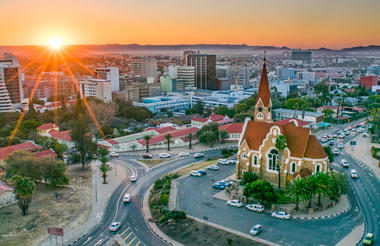
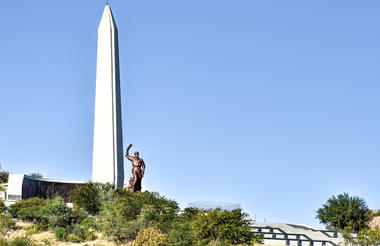
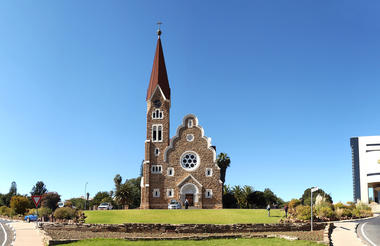
- Dinner
After breakfast this morning, your personal Ultimate Safaris guides will collect you from Galton House. You depart Windhoek and head north through small towns and farming communities as you make your way towards the sprawling bushveld of the Etosha National Park and neighboring Etosha Heights Private Reserve.
You arrive at the beautiful Safarihoek Lodge in the mid-afternoon with some time free to relax and freshen up before embarking on an exciting afternoon game drive on the lodge reserve, ending off with sundowners before returning to the lodge for dinner.
Safarihoek Lodge is located on Etosha Heights and is part of a 60,000ha privately owned game reserve which shares borders, for about 65kms, with Etosha National Park. It consists of 9 farms that were originally used for domestic farming. Over a period of time, acquired and combined to create a stunning wildlife reserve that they are now privileged to be part of. With an array of animals which include various species of antelope, predators, birds as well as others. Etosha Heights Namibia partakes in various conservation efforts and projects that are currently operational and many more still to come. The main goal and vision is to encourage and develop sustainable eco-friendly tourism, all to the benefit of the area, animals as well as the community.



Vulture Feeding
- All Meals & Schedule share afternoon game drives as offered by the lodge
Today you will explore the extensive Etosha Heights private reserve whilst out on exciting game drives today. You’ll go out in the morning, returning to the lodge for lunch and a time to relax before setting off once again in the late afternoon.
Etosha Heights Private Reserve: Founded in 1999, Etosha Heights is one of the largest private reserves in Namibia, sharing a 65-kilometre border with the famous Etosha National Park.
The reserve offers 60,000 hectares of unspoiled wildlife, landscapes, and tranquility; truly a place to reconnect with nature and escape the modern stresses of life. Wildlife-wise, you’ll find lion, cheetah, and many of Namibia’s fascinating desert species, but the reserve is probably most famous for its strong population of both black and white rhino



- All meals & schedule shared morning and afternoon game drives as offered by the lodge
Today’s journey takes you in a southwesterly direction past the Brandberg, Namibia’s tallest mountain standing at 2,574m in height, before heading south to reach the coastal town of Swakopmund, stopping en route to view the hauntingly beautiful Zeila shipwreck. Depending on your time of arrival and if time allows, you may wander around the town of Swakopmund and along the waterfront on foot if desired, before heading out to dinner at one of the popular restaurants in town with your guides.
Brandberg: The name Brandberg is Afrikaans, Dutch and German and means Fire Mountain, derived from the mountains glowing color which is sometimes seen in the setting sun. The Damara name for the mountain is Dâures, which means 'burning mountain', while the Herero name, Omukuruvaro means 'mountain of the Gods'. The Brandberg Massif or Brandberg Intrusion is a granitic intrusion, which forms a dome-shaped plateau. The geology of the area is typical of Damaraland, which is littered with eroded mountains, hills and koppies (small hills), which are made up of granite boulders. These piles of granite are ancient magma chambers, formed billions of years ago when underground volcanic activity was common in southern Africa. Over the millennia, these massive deposits of magma cooled and have been exposed, as we see them today, by the forces of erosion. The imposing Brandberg massif is Namibia’s highest mountain, its highest point is ‘Kings Rock’ or Konigstein with an elevation of 2,574m. The remaining circular inselberg has a diameter of about 25km. In addition to the interesting geology of the area, the mountain provides an oasis to a variety of flora and fauna including Namibia’s only endemic acacia, the Acacia montis-usti. The rocks also provided temporary shelter to indigenous nomadic people who left behind a mosaic of rock paintings totalling around 45,000 figures – making this one of Africa’s largest open air rock art galleries. The most famous, and controversial, rock painting found here is known as the ‘White Lady’.
The Zeila: The Zeila was stranded on 25 August 2008 in the early morning hours near "Die Walle", a popular fishing spot about 14km south of Henties Bay. The fishing trawler was sold as scrap metal to an Indian company by Hangana Fishing of Walvis Bay and ran aground after it came loose from its towing line while on its way to Bombay, India shortly after it left Walvis Bay. The rusting bulk is now home to hundreds of perching cormorants and other seabirds, an ominous reminder of why this stretch of beach is referred to as the Skeleton Coast.
Swakopmund: Swakopmund resembles a small, German coastal resort nestled between the desert and the sea. It boasts a charming combination of German colonial architecture blended with good hotels, shops, restaurants, museums, craft centers, galleries and cafés. Swakopmund had its beginnings as a landing station in 1892 when the German Reich erected the first building, a barracks for troops on the site. Settlers followed and attempted to create a harbor town by constructing a concrete Mole and then iron jetty failed. The advent of World War 1 halted developments and the town sank into decline until half a century later when infrastructures improved, and an asphalt road opened between Windhoek and Swakopmund. This made reaching the previously isolated town quicker and easier and it prospered once again to become Namibia’s premier resort town. Although the sea is normally cold for swimming there are pleasant beaches and the cooler climate is refreshing after the time spent in the desert.
Strand Hotel: The Strand Hotel has a prime location on the well known “Mole” beachfront and with its extensive, unique and creatively entertaining Restaurants, Bars, Deli, Lobby-Lounge, Sea Facing Terraces, Beach Kiosk and state of the art Conference & Banqueting Center, all set on the Mole, a historic and iconic site surrounded by Ocean on three sides, the Strand Hotel Swakopmund is a social epicentre and destination in itself for all visitors to and residents of Swakopmund. The hotel is in walking distance from the centre of town, and has long, sandy beaches right on its doorstep with a total of 125 rooms of which 90% have beach and sea views and 10% garden and park views. Each room is elegantly furnished and feature en-suite bathrooms, complimentary internet Wi-Fi access, Air Conditioning, Electronic Door Locks, Hairdryers, Safes, Direct Dial Telephones, LCD Television with Satellite TV Channels, Tea/Coffee Stations, Stocked Mini-Bars and Working Desks with 220v International Plug Points for Europe, UK and South Africa.
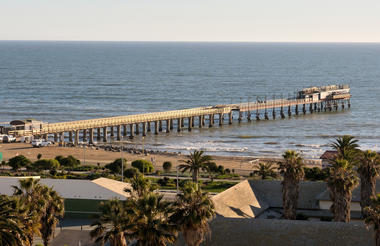
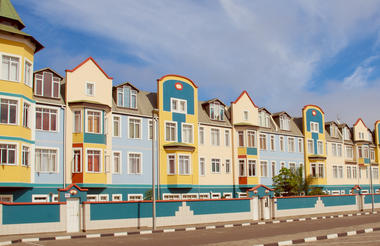
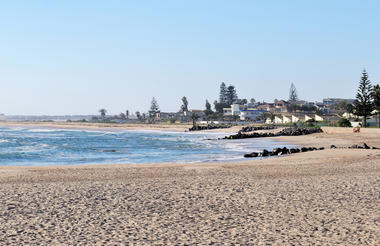
- All meals & sightseeing with Ultimate Safari Guides
This morning your Ultimate Safaris guides will drive you to the Walvis Bay lagoon where you will experience the harbour town from the waters of the harbour itself on a catamaran boat cruise. Glide silently and effortlessly past the massive ships docked in the harbour as you keep an eye out for playful seals and the possibility of dolphins in the breaks of the waves. Afterwards you head back to Swakopmund for a light lunch and an afternoon at leisure before rejoining your guides for dinner.
Walvis Bay: Walvis Bay is Namibia’s main Port town as well as being the base for a variety of fishing and recreational activities on the Lagoon and out at sea. The town is less of a seaside resort than Swakopmund, but it has a variety of areas that are of specific interest, especially to birders, including the Lagoon itself and the area around the salt works on the way out towards Pelican Point. The Port was a British Protectorate during the years that Southwest Africa was a German Colony and did not immediately become part of Namibia after Independence. In fact, it took almost another five years before that happened.
Dolphin & Seal Cruise: You depart from the Walvis Bay Yacht Club and cruise into the beautiful and sheltered bay area, which holds more splendour than can at first be seen – a shipwreck, lighthouse, oyster platforms, different bird species, seals and an abundance of marine life are just some of the attractions. The boat will move alongside oyster platforms where your guide will share more information with you about Walvis Bay’s own cultivated oysters, delicacies which you will later get to taste. The journey proceeds to the ever-growing Pelican Point to achieve a closer look at the lighthouse and resident seal colony. The old supply railway spoors can still be seen from the years when the lighthouse was occupied by the coast guards. Moving around the point, three different types of dolphins may be encountered, namely the Heaviside/Benguela Dolphins which are the most notable as they are endemic to the coast of Namibia, Dusky Dolphins and Atlantic Bottlenose Dolphins. Sightings of the Mola Mola (Sunfish) and the Leatherback Turtles also keep you on the lookout. All this can be experienced whilst comfortably relaxing in the saloon, on the trampolines, or on deck, and enjoying a glass of sparkling wine and delicious snacks.



- All meals, schedule shared AM Catamaran Boat Cruise & sightseeing with Ultimate Safari Guides
The fascinating drive today takes you south past the port town of Walvis Bay where you have the option to visit the lagoon to see the interesting mix of pelicans, flamingos, and other seabirds. Continuing southeast, the journey takes you through awesome and ever-changing desert landscapes via the impressive Gaub and Kuiseb canyons to meet the dunes at the settlement of Solitaire. You arrive at the beautiful Kwessi Dunes Lodge in the mid-afternoon where you will stay for the next two nights whilst you explore the remarkable sights of the Namib Desert with your guides. This afternoon you have the option to discover the surrounding area with your local lodge-based guide on a breathtaking sundowner drive as introduction to this unique part of the Namib Desert.
NamibRand Nature Reserve: The breathtaking Namib Rand Nature Reserve, one of the largest private nature reserves in Southern Africa, begun as a conservation initiative in 1984 and now extends over 180,000ha of pristine Namib Desert, restoring land that was once used for Karakul sheep farming. The reserve shares a common border of nearly 100km with the Namib-Naukluft National Park to the west, while the imposing Nubib mountain range forms a natural border to the east. The main attraction of Namib Rand is its diversity of different desert landscapes, representing virtually all facets of the Namib Desert with expansive sand and gravel plains and endless stretches of grass savannah alternate with majestic mountain ranges and vegetated dune belts of deep red sand. The variety of flora and fauna is as fascinating as the colour nuances of the landscape, which change continuously as the day progress. Before Namib Rand became a private nature reserve, it consisted of sheep farms, surveyed, and allocated in the early fifties to ex-soldiers of World War II. Today visitors to the Namib Rand can admire nature in its original state, as indigenous animals and plants are flourishing back where they belong.
Kwessi Dunes Lodge: Kwessi Dunes is located deep in Namibia’s striking NamibRand Nature Reserve, a vast desert wilderness of over 200,000ha. With its rolling desert plains and backdrop of craggy mountains and iconic red dunes, this is a place where time seems to stand still and the space is never-ending. Here, it’s not about chasing big game but rather soaking up the beauty of the colourful landscape, admiring the antelope that scatter the sand, and gazing at the stars the light up the night sky. At Kwessi Dunes, you’ll find 12 cool and comfortable (and air-conditioned) chalets all with canvas walls and thatched roofs. Each bedroom has a separate ‘star gazer’ room, completely open to the sky, and the perfect spot from which to watch the celestial theatre show above. Views from the rooms, the main area and the swimming pool are of the vast, desert vistas and when you can bear to tear your eyes away, enjoy quad biking, scenic drives and walks, hot air ballooning, helicopter flights, horse riding and day trips to Sossusvlei.



- All meals schedule shared lodge base-activities & local beverages
This morning you will rise early for a magical excursion into the Namib Naukluft National Park with your naturalist guides, entering the Park gates at sunrise to capture the dunes whilst the light is soft, and shadows accentuate their towering shapes and curves. This area boasts some of the highest free-standing sand dunes in the world. Your guides will give you an insight on the formation of the Namib Desert and its myriad of fascinating creatures and plants that have adapted to survive these harsh environs.
Once you have explored the dune fields to your heart’s content you can enjoy a relaxed picnic breakfast in the shade of a camel thorn tree. You then return to the lodge in the early afternoon for a late lunch, stopping off to view Sesriem Canyon along the way. The rest of the afternoon is at leisure (from experience, this is usually welcomed after an exhilarating morning in the dunes). You also have the option to head out on another scheduled shared afternoon activity as offered by the lodge.
Sossusvlei: This most frequently visited section of the massive 50,000km² Namib Naukluft National Park has become known as Sossusvlei, famous for its towering apricot colored sand dunes which can be reached by following the Tsauchab River valley. Sossusvlei itself is a clay pan set amidst these star shaped dunes which stand up to 300m above the surrounding plains, ranking them among the tallest dunes on earth. The deathly white clay pan contrasts against the orange sands and forms the endpoint of the ephemeral Tsauchab River, within the interior of the Great Sand Sea. The river course rises south of the Naukluft Mountains in the Great Escarpment. It penetrates the sand sea for some 55km before it finally peters out at Sossusvlei, about the same distance from the Atlantic Ocean. Until the encroaching dunes blocked its course around 60,000 years ago, the Tsauchab River once reached the sea as ephemeral rivers still do in the northern half of the Namib. Sand-locked pans to the west show where the river previously flowed to before dunes shifted its endpoint to where it currently gathers at Sossusvlei. Roughly once a decade rainfall over the catchment area is sufficient to bring the river down in flood and fill the pan. On such occasions the mirror images of dunes and camel thorn trees around the pan are reflected in the water. Sossusvlei is the biggest of four pans in the vicinity. Another, famous for its gnarled and ghostly camel thorn trees, is Deadvlei which can be reached on foot over 1km of sand. Deadvlei’s striking camel thorn trees; dead for want of water, still stand erect as they once grew. They survived until about 900 years ago when the sand sea finally blocked the river from occasionally flooding the pan.
Sesriem Canyon: Sesriem Canyon has evolved through centuries of erosion by the Tsauchab River which has incised a narrow gorge about 1.5km long and 30m deep into the surrounding conglomerates, exposing the varying layers of sedimentation deposited over millions of years. The shaded cool depths of the canyon allow pools of water to gather during the rainy season and remain for much of the year round. These pools were a vital source of water for early settlers who drew water for their livestock by knotting six (ses) lengths of rawhide thongs (riems) together, hence the canyon and surrounding area became known as Sesriem.
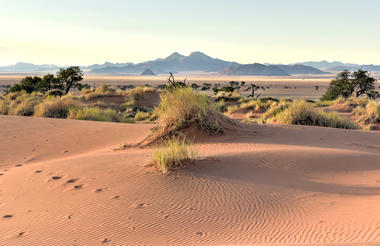
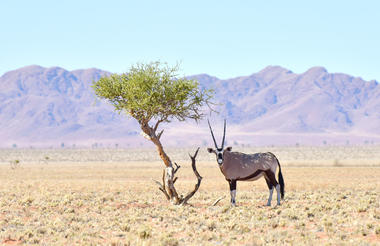
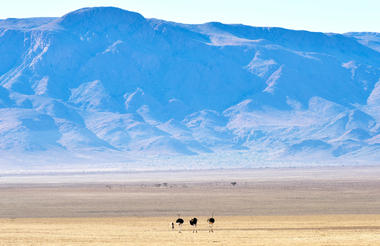
- All meals, schedule shared lodge-base activities, local beverages & excursions with Ultimate Safari Guides
After a leisurely breakfast you bid farewell to the Namib Desert, traversing the Great Escarpment and scenic Khomas Hochland highlands to make your way back to the capital city of Windhoek and then onwards to Hosea Kutako International Airport for your ongoing flight, getting you there in time for check in.
We wish you safe travels and hope that your Namibian safari has been full of unforgettable highlights and memorable experiences! ….. Bon Voyage!
Please note: International flights to depart no earlier than 18h00 to allow enough time for the drive from the Kwessi Dunes Lodge to Hosea Kutako International Airport.
Arrive at Victoria Falls Airport
Transfer to Victoria Falls Safari Club


Helicopter Flights Activities: Flight of Angels
Fly over the majestic gorges before orbiting over the Victoria Falls, followed by a return
over Long Island and Mosi‐oa‐Tunya National Park.
Flight over falls ‐ 15 minutes


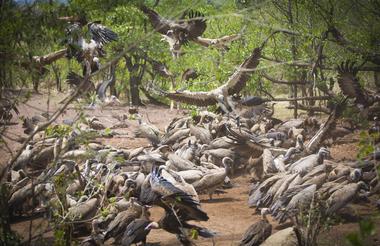
- 2 Nights Package (2 nights' accommodation Bed & Breakfast
- 1 x dinner at MaKuwa‐Kuwa Restaurant (Table d'hôtel Menu) or 1 x dinner at
- Victoria Falls Safari Club exclusive to Club guests
- 1 x dinner at The Boma ‐ Dinner & Drum Show, with courtesy return shuttle
- 1 x Vulture Culture lunch in the MaKuwa‐Kuwa Restaurant (Table d'hôtel
- Menu) or 1 x lunch at Victoria Falls Safari Club exclusive to Club guests
- Return seat in coach transfers from Victoria Falls Airport
- 1x Guided Tour of the Victoria Falls
- 1x Sunset Cruise (luxury deck ‐ Zambezi Explorer)
- Hourly courtesy shuttle to Victoria Falls Rainforest and town centre
- Complimentary Wi‐Fi
- Transfers
- 1 x 15 Minute Flight of Angels
Zimbabwe Transfers:
Victoria Falls Safari Club to Chobe
Bakwena Lodge Border road transfer. (Please note that this route involves
border crossing, as such, have the appropriate document ready for the
customs officials at the border.)
Approximate Travelling Time: 1 hour 20 minutes
Arrive at Chobe Safari Lodge
Chobe Boat Cruise
Dinner



- Breakfast & Dinner
- Chobe Boat Cruise including park fees
- Transfers
Breakfast
Under One Botswana Sky ‐ Transfers:
Road transfer
A shared road transfer from Chobe Safari Lodge to Kasane Airport
Approximate Trasfer Time: 15 minutes
Mack Air ‐ Mack Air (air transfer): Kasane Airport to Group B Camp / Lodge
Air transfer from Kasane Airport to Khwai Expeditions Camp on seat Rate Basis
with up to 3 possible stops en route.
Luggage restrictions apply.
Approximate Flying Time: 45 minutes



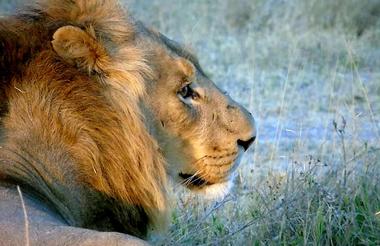
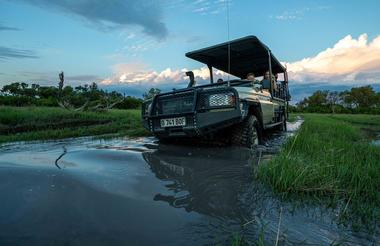
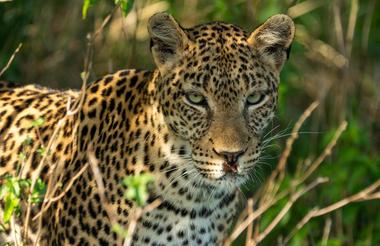
- Board Basis: Fully Inclusive
- Drinks Basis: All Drinks Excluding Premium Brands
Mack Air ‐ Mack Air (air transfer): Group B Camp / Lodge to Maun Airport
Air transfer from Khwai Expeditions Camp to Maun Airport on seat Rate Basis
with up to 3 possible stops en route.
Luggage restrictions apply.
Approximate Flying Time : 35 minutes




